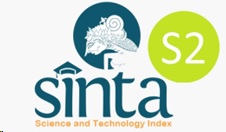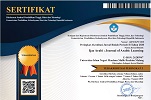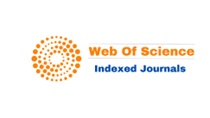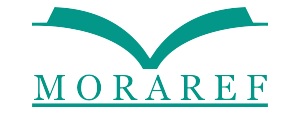Teachers' Profesional Competence In Teaching Arabic As A Foreign Language In Secondary Schools: A Praxeology Perspective
Abstract
Keywords
Full Text:
PDFReferences
Abdullah, M. R., Yaakob, M. A., Zulkifli, M. F., & Sahrir, M. S. (2023). A review of studies related to Arabic language learning based on the Common European Framework of Reference for Language (CEFR). Ijaz Arabi Journal of Arabic Learning, 6(2), 463-475. https://doi.org/10.18860/ijazarabi.v6i2.20386
Aflisia, N., Hendriyanto, H., & Suhartini, A. (2022). Arabic Language Development in Boarding Schools at the Industry Era 4.0: Potentials and Challenges. Alsuna: Journal of Arabic and English Language, 5(1), 45-61. https://doi.org/10.31538/alsuna.v5i1.2040
Al Farisi, M. Z., Sanusi, A., Khalid, S. M., & Tantowi, Y. A. (2021, November). Requesting Speech Acts: A Case Study of Arabic Education Students in Bandung. In Fifth International Conference on Language, Literature, Culture, and Education (ICOLLITE 2021) (pp. 454-459). Atlantis Press. https://doi.org/10.2991/assehr.k.211119.070
Albadawi, E. B., & Yazan, B. (2024). Family language policies during a global pandemic: challenges and opportunities for language maintenance in Arabic-English multilingual families in the USA. Multilingua, 43(2), 213-240. https://doi.org/10.1515/multi-2023-0015
Alharbi, A. M. (2022). Reading skills among EFL learners in Saudi Arabia: A review of challenges and solutions. World Journal of Advanced Research and Reviews, 15(3), 204-208. https://doi.org/10.30574/wjarr.2022.15.3.0922
Alkhatib, M., Monem, A. A., & Shaalan, K. (2020). Deep learning for Arabic error detection and correction. ACM Transactions on Asian and Low-Resource Language Information Processing (TALLIP), 19(5), 1-13. https://doi.org/10.1145/3373266
Al-Rawafi, A., Sudana, D., Lukmana, I., & Syihabuddin, S. (2021). Students’ apologizing in Arabic and English: An interlanguage pragmatic case study at an Islamic boarding school in Indonesia. Indonesian journal of applied linguistics, 10(3), 589-602. https://doi.org/10.17509/ijal.v10i3.31740
Anggraini, A., Sutaman, S., Anshory, A., & Muntaqim, A. (2021). Teacher's personality as a motivation in Arabic learning: a systematic review based on five professional teacher personality frameworks. Al-Ta'rib: Jurnal Ilmiah Program Studi Pendidikan Bahasa Arab IAIN Palangka Raya, 9(2), 145-154. https://doi.org/10.23971/altarib.v9i2.3263
Aslam, R., & Khan, N. (2020). Constructive feedback and Students’ academic achievement: a theoretical framework. New Horizons, 14(2), 175-198. http://dx.doi.org/10.2.9270/nh.14.2(20).10
Aung, P. N., & Hallinger, P. (2023). Research on sustainability leadership in higher education: A scoping review. International Journal of Sustainability in Higher Education, 24(3), 517-534. https://doi.org/10.1108/IJSHE-09-2021-0367
Bergmark, U., & Hansson, K. (2021). How teachers and principals enact the policy of building education in Sweden on a scientific foundation and proven experience: Challenges and opportunities. Scandinavian Journal of Educational Research, 65(3), 448-467. https://doi.org/10.1080/00313831.2020.1713883
Black, P., & Wiliam, D. (1998). 'Assessment and Classroom Learning. Assessment in Education: Principles, Policy & Practice, 5(1), 7 — 74. http://dx.doi.org/10.1080/0969595980050102
Black, P., & Wiliam, D. (2006). Developing a theory of formative assessment. In J. Gardner (Ed.), Assessment and learning. London: Sage.
Bosma, E., Bakker, A., Zenger, L., & Blom, E. (2023). Supporting the development of the bilingual lexicon through translanguaging: a realist review integrating psycholinguistics with educational sciences. European Journal of Psychology of Education, 38(1), 225-247. https://doi.org/10.1007/s10212-021-00586-6
Byram, M. (1997). Teaching and Assessing Intercultural Communicative Competence. Clevedon: Multilingual matters.
Cenoz, J., & Gorter, D. (2020). Teaching English through pedagogical translanguaging. World Englishes, 39(2), 300-311. https://doi.org/10.1111/weng.12462
Chan, K. K. H., & Yau, K. W. (2021). Using video-based interviews to investigate pre-service secondary science teachers’ situation-specific skills for informal formative assessment. International Journal of Science and Mathematics Education, 19(2), 289-311. https://doi.org/10.1007/s10763-020-10056-y
Cuartas Álvarez, L. F. (2020). Intercultural communicative competence: In-service EFL teachers building understanding through study groups. Profile: Issues in Teachers’ Professional Development, 22(1), 75-92. https://doi.org/10.15446/profile.v22n1.76796
Cummins, J. (2007). Rethinking monolingual instructional strategies in multilingual classrooms. Canadian journal of applied linguistics, 10(2), 221-240.
Edidarmo, T., Fudhaili, A., & Mahfuzo, M. R. (2023). The Power of Spiritual Motivation: A Conceptual and Theoretical Review of Arabic Language Learning. Arabiyatuna: Jurnal Bahasa Arab, 7(1), 315-344. http://dx.doi.org/10.29240/jba.v7i1.5629
Ellis, R. (2009). A typology of written corrective feedback types. ELT journal, 63(2), 97-107. https://doi.org/10.1093/elt/ccn023
Fochi, P. S. (2022). Pedagogical documentation as a strategy for planning and communicating children’s learning and pedagogical day-to-day life. European early childhood education research journal, 30(2), 227-238.
Hanifah, U., Mukhoiyaroh, M., & Gumilar, R. (2022). Online learning system for Arabic teacher professional education program in the digital era. Jurnal Al Bayan: Jurnal Jurusan Pendidikan Bahasa Arab, 14(1), 117-135. http://dx.doi.org/10.24042/albayan.v14i1.11321
Harmer, J. (1991). The practice of English Language Teaching. London: Longman.
Hattie, J., & Timperley, H. (2007). The power of feedback. Review of Educational Research, 77(1), 81-112. https://doi.org/10.3102/003465430298487
Horwitz, E. K., Horwitz, M. B., & Cope, J. (1986). Foreign Language Classroom Anxiety. The Modern Language Journal, 70(2), 125–132. https://doi.org/10.2307/327317
Hu, X., Zhang, X., & McGeown, S. (2024). Foreign language anxiety and achievement: A study of primary school students learning English in China. Language Teaching Research, 28(4), 1594-1615. https://doi.org/10.1177/13621688211032332
Kemmis, S., & McTaggart, R. (1988). The action researcher planner. Victoria: Deakin University.
Lado, R. (1957). Linguistic across cultures: Applied linguistic for language teachers. Ann Arbor, Michigan: University of Michigan.
Lightbown, P, & Spada, N. (1999). How languages are learned (Rev. ed.).Oxford, UK: Oxford University Press.
Mahfud, C., Astari, R., Kasdi, A., Arfan Mu'ammar, M., Muyasaroh, & Wajdi, F. (2021). Islamic cultural and Arabic linguistic influence on the languages of Nusantara from lexical borrowing to localized Islamic lifestyles. Wacana, 22(1), 224-248. https://doi.org/10.17510/wacana.v22i1.914
Mallarangan, A. D. D., Rahman, A., Nur, S., Lathifah, Z. K., & Lubis, F. M. (2024). Analysis Of The Influence Of Continuous Training Development And Education On Professional Competence Of Teachers In Public Schools. Journal on Education, 6(2), 13449-13456. https://doi.org/10.31004/joe.v6i2.5194
Masood, M. H., Shafi, S., Rahim, M. Y., & Darwesh, M. A. (2020). Interference of L1 (Urdu) in L2 (English) in Pakistan: Teaching English as a second language. International Journal of Applied Linguistics and English Literature, 9(5), 110-118. https://doi.org/10.7575/aiac.ijalel.v.9n.5p.110
Megawati, I., Widodo, P., Ashadi, & Triastuti, A. (2020). Teacher’s cognition of intercultural communicative competence in Indonesia EFL context. Elementary Education Online, 19(2), 42-49. http://dx.doi.org/10.17051/ilkonline.2020.02.105
Miao, X., & Wang, P. (2023). A literature review on factors affecting motivation for learning Arabic as a foreign language. Open Journal of Social Sciences, 11(6), 203-211. https://doi.org/10.4236/jss.2023.116014.
Mincu, M., Colman, A., Day, C., & Gu, Q. (2024). Lessons from two decades of research about successful school leadership in England: A humanistic approach. Education Sciences, 14(2), 1-15. https://doi.org/10.3390/educsci14020187Aca
Nurbayan, Y., Sanusi, A., Ismail, Z. B., & Saleh, N. (2023). Exploring Teachers' Didactic Multilingual Competence In Arabic Language Teaching As Foreign Language. Ijaz Arabi Journal of Arabic Learning, 6(3), 526-537. https://doi.org/10.18860/ijazarabi.v6i3.23305
Nurbayan, Y., Sauri, S., & Sanusi, A. (2021). Developing an International Standardized Arabic Language Education Curriculum: Introducing a Conception-Focused Design and Outcome. Al-Ta’rib: Jurnal Ilmiah Program Studi Pendidikan Bahasa Arab IAIN Palangka Raya, 9(2), 155-172. https://doi.org/10.23971/altarib.v9i2.3264
Panagiotidis, P., Krystalli, P., & Arvanitis, P. (2023). Technology as a motivational factor in foreign language learning. European Journal of Education (EJED), 6(1), 69-84.
Perkasa, D. H., Mulyanto, H., Susiang, M. I. N., Parashakti, R. D., & Rostina, C. N. (2023). Teacher Performance Post-Covid-19: A Study of Workload, Leadership Style, and Teacher Work Discipline at SMAN 21 Tangerang District. KnE Social Sciences, 11-21. https://doi.org/10.18502/kss.v8i12.13646
Rahardjo, M. (2017). Studi Kasus dalam Penelitian Kualitatif: Konsep dan Prosedurnya. Malang: UIN Malang Press.
Republik Indonesia. (2007). Permendiknas No.16 Tahun 2007 tentang Standar Kualifikasi Akademik dan Kompetensi Guru. Jakarta: Seketariat Negara.
Ruhendi, A.,& Kosim, N. (2022). Developing Arabic Language Teachers’ Competence and Performance through Teacher Profession Education. Jurnal Pendidikan Islam, 8(1), 37-50. https://doi.org/10.15575/jpi.v8i1.18243
Sagala, A. H. (2023). Planning and Strategies for Learning Sentence Structure Arabic Language: a Systemic Literature Review. WARAQAT: Jurnal Ilmu-Ilmu Keislaman, 8(1), 114-127. https://doi.org/10.51590/waraqat.v8i1.423
Sanusi, A., Hamid, M. A., Nurbayan, Y., Ismail, Z. B., & Maulia, L. N. (2024). Arabic Teachers Pedagogical Competence: Cultural Approach in Enhancing the Students' Communicative Skills. Arabiyat: Journal of Arabic Education & Arabic Studies/Jurnal Pendidikan Bahasa Arab dan Kebahasaaraban, 11(1)., 116-134. http://dx.doi.org/10.15408/a.v11i1.39919
Sanusi, A., Mubarak, M. R., & Al-Rawafi, A. (2022). Praxeology Concept: Investigating the Actions of Primary School Teachers in Achieving Arabic Teaching. Arabiyat: Journal of Arabic Education & Arabic Studies/Jurnal Pendidikan Bahasa Arab dan Kebahasaaraban, 9(1), 85-96. http://dx.doi.org/10.15408/a.v9i1.22636
Sanusi, A., Sauri, S., & Nurbayan, Y. (2020). Non-native Arabic language teacher: Low teacher’s professional competence low quality outcomes?. Arabiyat: Journal of Arabic Education & Arabic Studies/Jurnal Pendidikan Bahasa Arab dan Kebahasaaraban, 7(1), 45-60. http://dx.doi.org/10.15408/a.v7i1.12722
Sauri, S., Saepulloh., Sanusi, A. (2021). Guru Profesional Abad 21. Jakarta: Mustika Ilmu.
Savignon, S. J. (1997). Communicative Language Teaching: Linguistic Theory and Classroom Practice. New York: McGraw-Hill.
Schön, Donald. (1983). The reflective practitioner. New York: Basic Books
Shadiev, R., & Yang, M. (2020). Review of studies on technology-enhanced language learning and teaching. Sustainability, 12(2), 1-22. https://doi.org/10.3390/su12020524
Sherif, S. M., Alamoodi, A. H., Albahri, O. S., Garfan, S., Albahri, A. S., Deveci, M., Baker, R.S., & Kou, G. (2023). Lexicon annotation in sentiment analysis for dialectal Arabic: Systematic review of current trends and future directions. Information Processing & Management, 60(5), 103449. https://doi.org/10.1016/j.ipm.2023.103449
Spahiu, I., & Kryeziu, N. (2021). Grammatical mistakes of Albanian students in learning English as a foreign language. Linguistics and Culture Review, 5(S3), 814-822. https://doi.org/10.21744/lingcure.v5nS3.1366
Stanja, J., Gritz, W., Krugel, J., Hoppe, A., & Dannemann, S. (2023). Formative assessment strategies for students' conceptions—The potential of learning analytics. British Journal of Educational Technology, 54(1), 58-75. https://doi.org/10.1111/bjet.13288
Sukavatee, P., & Khlaisang, J. (2023). A survey of research into English teaching approaches and instructional media in Thailand. LEARN Journal: Language Education and Acquisition Research Network, 16(2), 752-769.
Swan, M. (1997). The influence of the mother tongue on second language vocabulary acquisition and use. (In Vocabulary: Description, Acquisition and Pedagogy, ed. Schmitt and McCarthy, CUP 1997, pp. 156–180). https://doi.org/10.3969/j.issn.1001-9960.2010.28.147
Towler, M. A. (2024). Language variation on Arabic undergraduate degree courses in England: students’ perspectives. The Language Learning Journal, 1–28. https://doi.org/10.1080/09571736.2024.2351938
Tukimin, R., Yusoff, N. M. R. N., & Baharudin, H. (2020). Source of ideas of teacher-generated innovation in teaching arabic language in primary schools. International Journal of Academic Research in Progressive Education and Development, 9(2), 717-727. http://dx.doi.org/10.6007/IJARPED/v9-i2/8893
Utomo, H.B (2018). Teacher Motivation Behavior: The Importance Of Personal Expectations, Need Satisfaction, And Work Climate. International Journal of Pedagogy and Teacher Education. 2(2), 333-342. https://doi.org/10.20961/ijpte.v2i2.24036
Visonà, M. W., & Plonsky, L. (2020). Arabic as a heritage language: A scoping review. International Journal of Bilingualism, 24(4), 599-615. https://doi.org/10.1177/1367006919849110
Wahyuni, S., Ritonga, M., & Afrianti, W. (2023). Systematic Review of Learning Method for Teaching Arabic Listening and Speaking Skills. Al-Hayat: Journal of Islamic Education, 7(1), 30-41. https://doi.org/10.35723/ajie.v7i1.321.
Zhao, Y. (2003). Recent developments in technology and language learning: A literature review and meta-analysis. CALICO journal, 21 (1), 7-27.
DOI: https://doi.org/10.18860/ijazarabi.v8i1.29237
Refbacks
- There are currently no refbacks.
Copyright (c) 2025 Yayan Nurbayan, Anwar Sanusi, Mad Ali, Zawawi Bin Ismail, Mia Nurmala
License URL: https://creativecommons.org/licenses/by-sa/4.0/












